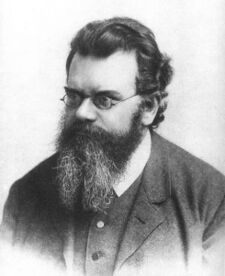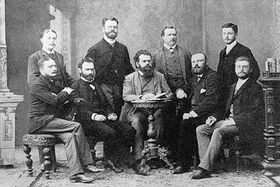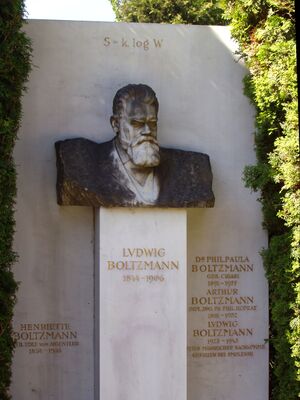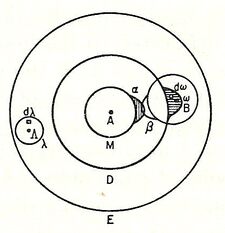路德维希·玻尔兹曼 Ludwig Edward Boltzmann
本词条由栗子CUGB初步翻译
路德维希·玻尔兹曼 Ludwig Edward Boltzmann | |
|---|---|
 路德维希·玻尔兹曼 | |
| Born | 路德维希·爱德华·玻尔兹曼 1844年2月20日 维也纳,奥地利帝国(1867年改组为奥匈帝国) |
| Died | 1906年9月5日 杜伊诺, 的里雅斯特, 奥匈帝国 |
| Cause of death | 上吊自杀 |
| Nationality | 奥地利 |
| Alma mater | 维也纳大学 |
| Known for | |
| Scientific career | |
| Fields | 物理学,哲学 |
| Institutions |
|
| Doctoral advisor | Josef Stefan |
| Other academic advisors | |
| Doctoral students | |
| Other notable students | |
| Signature | |
Ludwig Eduard Boltzmann (German pronunciation: [ˈluːtvɪg ˈbɔlt͡sman]; February 20, 1844 – September 5, 1906) was an Austrian physicist and philosopher. His greatest achievements were the development of statistical mechanics, and the statistical explanation of the second law of thermodynamics. In 1877 he provided the current definition of entropy,[math]\displaystyle{ \lt math\gt S = k_{\rm B} \ln \Omega \!\lt math\gt }[/math], interpreted as a measure of statistical disorder of a system.[1] Max Planck named the constant, kB, the Boltzmann constant.[2]
路德维希·爱德华·玻尔兹曼(1844年2月20日—1906年9月5日),奥地利物理学家、哲学家。他最伟大的功绩是发展了统计力学,并且从统计意义出发解释了热力学第二定律。1877年,他给出了目前熵的定义,即玻尔兹曼熵公式:[math]\displaystyle{ \lt math\gt S = k_{\rm B} \ln \Omega \!\lt math\gt }[/math],将熵解释为系统统计无序性的度量[1]。马克斯·普朗克命名kB为玻尔兹曼常数。
Statistical mechanics is one of the pillars of modern physics. It describes how macroscopic observations (such as temperature and pressure) are related to microscopic parameters that fluctuate around an average. It connects thermodynamic quantities (such as heat capacity) to microscopic behavior, whereas, in classical thermodynamics, the only available option would be to measure and tabulate such quantities for various materials.[3]
统计力学是现代物理学的支柱之一。它描述了宏观观察量(如温度和压力)如何与围绕平均值波动的微观参数相联系。它将热力学量(比如热容)与微观行为联系起来,而在经典热力学中,唯一可行的选择就是测量各种材料的热力学量,然后列成表格。
个人简介
童年时光与教育经历
Boltzmann was born in Erdberg, a suburb of Vienna. His father, Ludwig Georg Boltzmann, was a revenue official. His grandfather, who had moved to Vienna from Berlin, was a clock manufacturer, and Boltzmann's mother, Katharina Pauernfeind, was originally from Salzburg. He received his primary education at the home of his parents.[4] Boltzmann attended high school in Linz, Upper Austria. When Boltzmann was 15, his father died.[5]
玻尔兹曼出生在维也纳郊区的埃尔德伯格。祖父从柏林搬到维也纳,是一名钟表制造商。父亲路德维希·格奥尔格·玻尔兹曼是一名税务官员,母亲卡塔琳娜·波恩芬德来自萨尔茨堡。他在父母家里接受了初等教育。高中时光在上奥地利的林茨度过。玻尔兹曼15岁时,他的父亲去世了。
Starting in 1863, Boltzmann studied mathematics and physics at the University of Vienna. He received his doctorate in 1866 and his venia legendi in 1869. Boltzmann worked closely with Josef Stefan, director of the institute of physics. It was Stefan who introduced Boltzmann to Maxwell's work.[5]
从1863年开始,玻尔兹曼在维也纳大学学习数学和物理。他于1866年获得博士学位,1869年获得venia legendi(任教资格)。波尔兹曼与物理研究所所长约瑟夫·斯特凡(Josef Stefan)密切合作。正是斯特凡把玻尔兹曼引入了麦克斯韦的研究。
学术生涯
In 1869 at age 25, thanks to a letter of recommendation written by Stefan,[6] Boltzmann was appointed full Professor of Mathematical Physics at the University of Graz in the province of Styria. In 1869 he spent several months in Heidelberg working with Robert Bunsen and Leo Königsberger and in 1871 with Gustav Kirchhoff and Hermann von Helmholtz in Berlin. In 1873 Boltzmann joined the University of Vienna as Professor of Mathematics and there he stayed until 1876.
1869年,25岁的玻尔兹曼经斯特凡的推荐,被任命为斯蒂里亚省格拉茨大学的数学物理正教授。1869年,他在海德堡与罗伯特·本森和里奥·柯尼斯堡一起工作数月,1871年在柏林与古斯塔夫·基尔霍夫和赫尔曼·冯·赫姆霍尔兹一起工作。1873年玻尔兹曼加入维也纳大学担任数学教授,直至1876年。

In 1872, long before women were admitted to Austrian universities, he met Henriette von Aigentler, an aspiring teacher of mathematics and physics in Graz. She was refused permission to audit lectures unofficially. Boltzmann supported her decision to appeal, which was successful. On July 17, 1876 Ludwig Boltzmann married Henriette; they had three daughters: Henriette (1880), Ida (1884) and Else (1891); and a son, Arthur Ludwig (1881).[7] Boltzmann went back to Graz to take up the chair of Experimental Physics. Among his students in Graz were Svante Arrhenius and Walther Nernst.[8][9] He spent 14 happy years in Graz and it was there that he developed his statistical concept of nature.
1872年,远在女性可以被奥地利大学录取之前,他遇到了亨里埃特·冯·艾根特勒,这是一位有抱负的格拉茨数学和物理女教师。然而她被拒绝旁听大学讲座。玻尔兹曼支持她上诉的决定,之后上诉成功。1876年7月17日,路德维希·玻尔兹曼与亨里埃特结婚;他们共育有三女一子:亨里埃特(1880年)、艾达(1884年)、爱尔莎(1891年)、亚瑟·路德维希(1881年)。玻尔兹曼回到格拉茨担任实验物理学的主席。他在格拉茨的学生中有斯凡特·阿伦尼乌斯和瓦尔特·能斯特。
他在格拉茨度过了快乐的14年,正是在那里,他发展了他的自然界的统计概念。
Boltzmann was appointed to the Chair of Theoretical Physics at the University of Munich in Bavaria, Germany in 1890.
玻尔兹曼于1890年被任命为德国巴伐利亚慕尼黑大学理论物理学主席。
In 1894, Boltzmann succeeded his teacher Joseph Stefan as Professor of Theoretical Physics at the University of Vienna.
1894年,波尔兹曼接替他的老师约瑟夫·斯特凡成为维也纳大学理论物理学教授。
晚年生活与逝世缘由
Boltzmann spent a great deal of effort in his final years defending his theories.[10] He did not get along with some of his colleagues in Vienna, particularly Ernst Mach, who became a professor of philosophy and history of sciences in 1895. That same year Georg Helm and Wilhelm Ostwald presented their position on energetics at a meeting in Lübeck. They saw energy, and not matter, as the chief component of the universe. Boltzmann's position carried the day among other physicists who supported his atomic theories in the debate.[11] In 1900, Boltzmann went to the University of Leipzig, on the invitation of Wilhelm Ostwald. Ostwald offered Boltzmann the professorial chair in physics, which became vacant when Gustav Heinrich Wiedemann died. After Mach retired due to bad health, Boltzmann returned to Vienna in 1902.[10] In 1903, Boltzmann, together with Gustav von Escherich and Emil Müller, founded the Austrian Mathematical Society. His students included Karl Přibram, Paul Ehrenfest and Lise Meitner.[10]
晚年的玻尔兹曼致力于维护自己所创立的理论。在维也纳,他和一些同事相处不很融洽,尤其是恩斯特·马赫(Ernst Mach,1895年成为哲学和科学史教授)。1895年,格奥尔格·赫尔姆(Georg Helm)和威廉·奥斯特瓦尔德(Wilhelm Ostwald)在吕贝克的一次会议上提出了他们关于能量学的观点。他们认为宇宙的主要组成部分是能量,而不是物质。会议辩论中玻尔兹曼的观点赢得了其他支持原子理论的物理学家的赞同。在威廉·奥斯特瓦尔德的邀请下,玻尔兹曼于1900年前往莱比锡大学,填补辞世的古斯塔夫·海因里希·维德曼留下的空缺,出任物理学首席教授。在马赫因健康原因退休以后,玻尔兹曼于1902年返回维也纳。1903年,玻尔兹曼与古斯塔夫·冯·埃舍里希、埃米尔·穆勒一同创立了奥地利数学学会。他的门生包括:卡尔·普里贝拉姆(经济学家),保罗·埃伦费斯特(理论物理学家),丽斯·迈特纳(物理学家,被爱因斯坦称为“德国居里夫人”)。
In Vienna, Boltzmann taught physics and also lectured on philosophy. Boltzmann's lectures on natural philosophy were very popular and received considerable attention. His first lecture was an enormous success. Even though the largest lecture hall had been chosen for it, the people stood all the way down the staircase. Because of the great successes of Boltzmann's philosophical lectures, the Emperor invited him for a reception at the Palace.[12]
在维也纳大学,玻尔兹曼教授物理和哲学。他有关自然哲学的讲座颇受欢迎。开课当天,即使已经事先安排了最大的讲堂,现场依然是座无虚席,观者如山。讲座取得巨大成功,轰动全国,奥匈帝国皇帝也邀请玻尔兹曼入宫进行招待。
In 1906, Boltzmann's deteriorating mental condition forced him to resign his position, and his symptoms indicate he experienced what would today be diagnosed as bipolar disorder.[10][13] Four months later he died by suicide on September 5, 1906, by hanging himself while on vacation with his wife and daughter in Duino, near Trieste (then Austria).[14][15][16][13]
1906年,玻尔兹曼日渐恶化的精神状况迫使他辞去教职。后人对他当时的症状进行分析得出了躁郁症的结论。四个月后,在和妻女的度假过程中,他选择上吊自杀结束自己的痛苦和生命,终年63岁。
He is buried in the Viennese Zentralfriedhof. His tombstone bears the inscription of Boltzmann's entropy formula: [math]\displaystyle{ S = k \cdot \log W }[/math][10]
他被葬在维也纳中央弗里德霍夫博物馆。墓碑上刻着玻尔兹曼熵公式:[math]\displaystyle{ S = k \cdot \log W }[/math][10]
Philosophy
模板:Unreferenced section Boltzmann's kinetic theory of gases seemed to presuppose the reality of atoms and molecules, but almost all German philosophers and many scientists like Ernst Mach and the physical chemist Wilhelm Ostwald disbelieved their existence.[17] During the 1890s, Boltzmann attempted to formulate a compromise position which would allow both atomists and anti-atomists to do physics without arguing over atoms. His solution was to use Hertz's theory that atoms were Bilder, that is, models or pictures. Atomists could think the pictures were the real atoms while the anti-atomists could think of the pictures as representing a useful but unreal model, but this did not fully satisfy either group. Furthermore, Ostwald and many defenders of "pure thermodynamics" were trying hard to refute the kinetic theory of gases and statistical mechanics because of Boltzmann's assumptions about atoms and molecules and especially statistical interpretation of the second law of thermodynamics.
Around the turn of the century, Boltzmann's science was being threatened by another philosophical objection. Some physicists, including Mach's student, Gustav Jaumann, interpreted Hertz to mean that all electromagnetic behavior is continuous, as if there were no atoms and molecules, and likewise as if all physical behavior were ultimately electromagnetic. This movement around 1900 deeply depressed Boltzmann since it could mean the end of his kinetic theory and statistical interpretation of the second law of thermodynamics.
After Mach's resignation in Vienna in 1901, Boltzmann returned there and decided to become a philosopher himself to refute philosophical objections to his physics, but he soon became discouraged again. In 1904 at a physics conference in St. Louis most physicists seemed to reject atoms and he was not even invited to the physics section. Rather, he was stuck in a section called "applied mathematics", he violently attacked philosophy, especially on allegedly Darwinian grounds but actually in terms of Lamarck's theory of the inheritance of acquired characteristics that people inherited bad philosophy from the past and that it was hard for scientists to overcome such inheritance.
In 1905 Boltzmann corresponded extensively with the Austro-German philosopher Franz Brentano with the hope of gaining a better mastery of philosophy, apparently, so that he could better refute its relevancy in science, but he became discouraged about this approach as well.
Physics
Boltzmann's most important scientific contributions were in kinetic theory, including for motivating the Maxwell–Boltzmann distribution as a description of molecular speeds in a gas. Maxwell–Boltzmann statistics and the Boltzmann distribution remain central in the foundations of classical statistical mechanics. They are also applicable to other phenomena that do not require quantum statistics and provide insight into the meaning of temperature.
Most chemists, since the discoveries of John Dalton in 1808, and James Clerk Maxwell in Scotland and Josiah Willard Gibbs in the United States, shared Boltzmann's belief in atoms and molecules, but much of the physics establishment did not share this belief until decades later. Boltzmann had a long-running dispute with the editor of the preeminent German physics journal of his day, who refused to let Boltzmann refer to atoms and molecules as anything other than convenient theoretical constructs. Only a couple of years after Boltzmann's death, Perrin's studies of colloidal suspensions (1908–1909), based on Einstein's theoretical studies of 1905, confirmed the values of Avogadro's number and Boltzmann's constant, convincing the world that the tiny particles really exist.
To quote Planck, "The logarithmic connection between entropy and probability was first stated by L. Boltzmann in his kinetic theory of gases".[18] This famous formula for entropy S is[19][20]
- [math]\displaystyle{ S = k_B \ln W }[/math]
where kB is Boltzmann's constant, and ln is the natural logarithm. W is Wahrscheinlichkeit, a German word meaning the probability of occurrence of a macrostate[21] or, more precisely, the number of possible microstates corresponding to the macroscopic state of a system — the number of (unobservable) "ways" in the (observable) thermodynamic state of a system that can be realized by assigning different positions and momenta to the various molecules. Boltzmann's paradigm was an ideal gas of N identical particles, of which Ni are in the ith microscopic condition (range) of position and momentum. W can be counted using the formula for permutations
- [math]\displaystyle{ W = N! \prod_i \frac{1}{N_i!} }[/math]
where i ranges over all possible molecular conditions, and where [math]\displaystyle{ ! }[/math] denotes factorial. The "correction" in the denominator account for indistinguishable particles in the same condition.
Boltzmann could also be considered one of the forerunners of quantum mechanics due to his suggestion in 1877 that the energy levels of a physical system could be discrete.
Boltzmann equation
The Boltzmann equation was developed to describe the dynamics of an ideal gas.
- [math]\displaystyle{ \frac{\partial f}{\partial t}+ v \frac{\partial f}{\partial x}+ \frac{F}{m} \frac{\partial f}{\partial v} = \frac{\partial f}{\partial t}\left.{\!\!\frac{}{}}\right|_\mathrm{collision} }[/math]
where ƒ represents the distribution function of single-particle position and momentum at a given time (see the Maxwell–Boltzmann distribution), F is a force, m is the mass of a particle, t is the time and v is an average velocity of particles.
This equation describes the temporal and spatial variation of the probability distribution for the position and momentum of a density distribution of a cloud of points in single-particle phase space. (See Hamiltonian mechanics.) The first term on the left-hand side represents the explicit time variation of the distribution function, while the second term gives the spatial variation, and the third term describes the effect of any force acting on the particles. The right-hand side of the equation represents the effect of collisions.
In principle, the above equation completely describes the dynamics of an ensemble of gas particles, given appropriate boundary conditions. This first-order differential equation has a deceptively simple appearance, since ƒ can represent an arbitrary single-particle distribution function. Also, the force acting on the particles depends directly on the velocity distribution function ƒ. The Boltzmann equation is notoriously difficult to integrate. David Hilbert spent years trying to solve it without any real success.
The form of the collision term assumed by Boltzmann was approximate. However, for an ideal gas the standard Chapman–Enskog solution of the Boltzmann equation is highly accurate. It is expected to lead to incorrect results for an ideal gas only under shock wave conditions.
Boltzmann tried for many years to "prove" the second law of thermodynamics using his gas-dynamical equation — his famous H-theorem. However the key assumption he made in formulating the collision term was "molecular chaos", an assumption which breaks time-reversal symmetry as is necessary for anything which could imply the second law. It was from the probabilistic assumption alone that Boltzmann's apparent success emanated, so his long dispute with Loschmidt and others over Loschmidt's paradox ultimately ended in his failure.
Finally, in the 1970s E.G.D. Cohen and J. R. Dorfman proved that a systematic (power series) extension of the Boltzmann equation to high densities is mathematically impossible. Consequently, nonequilibrium statistical mechanics for dense gases and liquids focuses on the Green–Kubo relations, the fluctuation theorem, and other approaches instead.
Second thermodynamics law as a law of disorder

The idea that the second law of thermodynamics or "entropy law" is a law of disorder (or that dynamically ordered states are "infinitely improbable") is due to Boltzmann's view of the second law of thermodynamics.
In particular, it was Boltzmann's attempt to reduce it to a stochastic collision function, or law of probability following from the random collisions of mechanical particles. Following Maxwell,[22] Boltzmann modeled gas molecules as colliding billiard balls in a box, noting that with each collision nonequilibrium velocity distributions (groups of molecules moving at the same speed and in the same direction) would become increasingly disordered leading to a final state of macroscopic uniformity and maximum microscopic disorder or the state of maximum entropy (where the macroscopic uniformity corresponds to the obliteration of all field potentials or gradients).[23] The second law, he argued, was thus simply the result of the fact that in a world of mechanically colliding particles disordered states are the most probable. Because there are so many more possible disordered states than ordered ones, a system will almost always be found either in the state of maximum disorder – the macrostate with the greatest number of accessible microstates such as a gas in a box at equilibrium – or moving towards it. A dynamically ordered state, one with molecules moving "at the same speed and in the same direction", Boltzmann concluded, is thus "the most improbable case conceivable...an infinitely improbable configuration of energy."[24]
Boltzmann accomplished the feat of showing that the second law of thermodynamics is only a statistical fact. The gradual disordering of energy is analogous to the disordering of an initially ordered pack of cards under repeated shuffling, and just as the cards will finally return to their original order if shuffled a gigantic number of times, so the entire universe must some-day regain, by pure chance, the state from which it first set out. (This optimistic coda to the idea of the dying universe becomes somewhat muted when one attempts to estimate the timeline which will probably elapse before it spontaneously occurs.)[25] The tendency for entropy increase seems to cause difficulty to beginners in thermodynamics, but is easy to understand from the standpoint of the theory of probability. Consider two ordinary dice, with both sixes face up. After the dice are shaken, the chance of finding these two sixes face up is small (1 in 36); thus one can say that the random motion (the agitation) of the dice, like the chaotic collisions of molecules because of thermal energy, causes the less probable state to change to one that is more probable. With millions of dice, like the millions of atoms involved in thermodynamic calculations, the probability of their all being sixes becomes so vanishingly small that the system must move to one of the more probable states.[26] However, mathematically the odds of all the dice results not being a pair sixes is also as hard as the ones of all of them being sixes[citation needed], and since statistically the data tend to balance, one in every 36 pairs of dice will tend to be a pair of sixes, and the cards -when shuffled- will sometimes present a certain temporary sequence order even if in its whole the deck was disordered.
Awards and honours
In 1885 he became a member of the Imperial Austrian Academy of Sciences and in 1887 he became the President of the University of Graz. He was elected a member of the Royal Swedish Academy of Sciences in 1888 and a Foreign Member of the Royal Society (ForMemRS) in 1899.[27] Numerous things are named in his honour.
See also
References
- ↑ 1.0 1.1 Klein, Martin (1970). "Boltzmann, Ludwig". In Preece, Warren E. (in English). Encyclopædia Britannica (hard cover). 3 (Commemorative Edition for Expo 70 ed.). Chicago: William Benton. p. 893a. ISBN 0852291353.
- ↑ Partington, J.R. (1949), An Advanced Treatise on Physical Chemistry, vol. volume 1, Fundamental Principles, The Properties of Gases, London: Longmans, Green and Co., p. 300
{{citation}}:|volume=has extra text (help) - ↑ Gibbs, Josiah Willard (1902). Elementary Principles in Statistical Mechanics. New York: Charles Scribner's Sons.
- ↑ Simmons, John; Simmons, Lynda (2000). The Scientific 100. Kensington Publishing Corp.. p. 123. ISBN 9780806536781.
- ↑ 5.0 5.1 James, Ioan (2004). Remarkable Physicists: From Galileo to Yukawa. Cambridge University Press. p. 169. ISBN 9780521017060. https://archive.org/details/remarkablephysic00jame.
- ↑ Južnič, Stanislav (December 2001). "Ludwig Boltzmann in prva študentka fizike in matematike slovenskega rodu" [Ludwig Boltzmann and the First Student of Physics and Mathematics of Slovene Descent]. Kvarkadabra.net (in Slovenian) (12). Retrieved 17 February 2012.
{{cite journal}}: CS1 maint: unrecognized language (link) - ↑ https://www.boltzmann.com/ludwig-boltzmann/biography/
- ↑ Jäger, Gustav; Nabl, Josef; Meyer, Stephan (April 1999). "Three Assistants on Boltzmann". Synthese. 119 (1–2): 69–84. doi:10.1023/A:1005239104047. S2CID 30499879.
Paul Ehrenfest (1880–1933) along with Nernst, Arrhenius, and Meitner must be considered among Boltzmann's most outstanding students.
- ↑ "Walther Hermann Nernst". Archived from the original on 2008-06-12.
Walther Hermann Nernst visited lectures by Ludwig Boltzmann
- ↑ 10.0 10.1 10.2 10.3 10.4 10.5 Cercignani, Carlo (1998) Ludwig Boltzmann: The Man Who Trusted Atoms. Oxford University Press.
- ↑ Max Planck (1896). "Gegen die neure Energetik". Annalen der Physik. 57 (1): 72–78. Bibcode:1896AnP...293...72P. doi:10.1002/andp.18962930107.
- ↑ The Boltzmann Equation: Theory and Applications, E.G.D. Cohen, W. Thirring, ed., Springer Science & Business Media, 2012
- ↑ 13.0 13.1 Nina Bausek and Stefan Washietl (February 13, 2018). "Tragic deaths in science: Ludwig Boltzmann — a mind in disorder". Paperpile. Retrieved 2020-04-26.
- ↑ "Eureka! Science's greatest thinkers and their key breakthroughs", Hazel Muir, p.152,
- ↑ Boltzmann, Ludwig (1995). "Conclusions". In Blackmore, John T.. Ludwig Boltzmann: His Later Life and Philosophy, 1900-1906. 2. Springer. pp. 206–207. ISBN 978-0-7923-3464-4. https://books.google.com/books?id=apip-Jm9WuwC&pg=PA207.
- ↑ Upon Boltzmann's death, Friedrich ("Fritz") Hasenöhrl became his successor in the professorial chair of physics at Vienna.
- ↑ Bronowski, Jacob (1974). "World Within World". The Ascent Of Man. Little Brown & Co. p. 265. ISBN 978-0-316-10930-7. https://archive.org/details/ascentofmanbron00bron.
- ↑ Max Planck, p. 119.
- ↑ The concept of entropy was introduced by Rudolf Clausius in 1865. He was the first to enunciate the second law of thermodynamics by saying that "entropy always increases".
- ↑ An alternative is the information entropy definition introduced in 1948 by Claude Shannon.[1] It was intended for use in communication theory, but is applicable in all areas. It reduces to Boltzmann's expression when all the probabilities are equal, but can, of course, be used when they are not. Its virtue is that it yields immediate results without resorting to factorials or Stirling's approximation. Similar formulas are found, however, as far back as the work of Boltzmann, and explicitly in Gibbs (see reference).
- ↑ Pauli, Wolfgang (1973). Statistical Mechanics. Cambridge: MIT Press. ISBN 978-0-262-66035-8., p. 21
- ↑ Maxwell, J. (1871). Theory of heat. London: Longmans, Green & Co.
- ↑ Boltzmann, L. (1974). The second law of thermodynamics. Populare Schriften, Essay 3, address to a formal meeting of the Imperial Academy of Science, 29 May 1886, reprinted in Ludwig Boltzmann, Theoretical physics and philosophical problem, S. G. Brush (Trans.). Boston: Reidel. (Original work published 1886)
- ↑ Boltzmann, L. (1974). The second law of thermodynamics. p. 20
- ↑ "Collier's Encyclopedia", Volume 19 Phyfe to Reni, "Physics", by David Park, p. 15
- ↑ "Collier's Encyclopedia", Volume 22 Sylt to Uruguay, Thermodynamics, by Leo Peters, p. 275
- ↑ "Fellows of the Royal Society". London: Royal Society. Archived from the original on 2015-03-16.
Further reading
- Roman Sexl & John Blackmore (eds.), "Ludwig Boltzmann – Ausgewahlte Abhandlungen", (Ludwig Boltzmann Gesamtausgabe, Band 8), Vieweg, Braunschweig, 1982.
- John Blackmore (ed.), "Ludwig Boltzmann – His Later Life and Philosophy, 1900–1906, Book One: A Documentary History", Kluwer, 1995.
- John Blackmore, "Ludwig Boltzmann – His Later Life and Philosophy, 1900–1906, Book Two: The Philosopher", Kluwer, Dordrecht, Netherlands, 1995.
- John Blackmore (ed.), "Ludwig Boltzmann – Troubled Genius as Philosopher", in Synthese, Volume 119, Nos. 1 & 2, 1999, pp. 1–232.
- Blundell, Stephen; Blundell, Katherine M. (2006). Concepts in Thermal Physics. Oxford University Press. p. 29. ISBN 978-0-19-856769-1. https://books.google.com/books?id=vuBHXwAACAAJ.
- Boltzmann, Ludwig Boltzmann – Leben und Briefe, ed., Walter Hoeflechner, Akademische Druck- u. Verlagsanstalt. Graz, Oesterreich, 1994
- Brush, Stephen G. (ed. & tr.), Boltzmann, Lectures on Gas Theory, Berkeley, California: U. of California Press, 1964
- Brush, Stephen G. (ed.), Kinetic Theory, New York: Pergamon Press, 1965
- Brush, Stephen G. (1970). "Boltzmann". In Charles Coulston Gillispie. Dictionary of Scientific Biography. New York: Scribner. ISBN 978-0-684-16962-0. https://archive.org/details/dictionaryofsci001gill.
- Brush, Stephen G. (1986). The Kind of Motion We Call Heat: A History of the Kinetic Theory of Gases. Amsterdam: North-Holland. ISBN 978-0-7204-0370-1.
- Cercignani, Carlo (1998). Ludwig Boltzmann: The Man Who Trusted Atoms. Oxford University Press. ISBN 9780198501541. https://archive.org/details/ludwigboltzmannm0000cerc.
- Darrigol, Olivier (2018). Atoms, Mechanics, and Probability: Ludwig Boltzmann's Statistico-Mechanical. Oxford University Press. ISBN 978-0-19-881617-1. https://books.google.com/books?id=APBIDwAAQBAJ&pg=PA376.
- Ehrenfest, P. & Ehrenfest, T. (1911) "Begriffliche Grundlagen der statistischen Auffassung in der Mechanik", in Encyklopädie der mathematischen Wissenschaften mit Einschluß ihrer Anwendungen Band IV, 2. Teil ( F. Klein and C. Müller (eds.). Leipzig: Teubner, pp. 3–90. Translated as The Conceptual Foundations of the Statistical Approach in Mechanics. New York: Cornell University Press, 1959.
- Everdell, William R (1988). "The Problem of Continuity and the Origins of Modernism: 1870–1913". History of European Ideas. 9 (5): 531–552. doi:10.1016/0191-6599(88)90001-0.
- Everdell, William R (1997). The First Moderns. Chicago: University of Chicago Press. https://archive.org/details/firstmodernsprof00ever.
- Gibbs, Josiah Willard (1902). Elementary Principles in Statistical Mechanics, developed with especial reference to the rational foundation of thermodynamics. New York: Charles Scribner's Sons.
- Johnson, Eric (2018). Anxiety and the Equation: Understanding Boltzmann's Entropy. The MIT Press. ISBN 978-0-262-03861-4.
- Klein, Martin J. (1973). "The Development of Boltzmann's Statistical Ideas". In E.G.D. Cohen. The Boltzmann Equation: Theory and Applications. Acta physica Austriaca Suppl. 10. Wien: Springer. pp. 53–106. ISBN 978-0-387-81137-6. https://archive.org/details/boltzmannequatio00schm.
- Lindley, David (2001). Boltzmann's Atom: The Great Debate That Launched A Revolution In Physics. New York: Free Press. ISBN 978-0-684-85186-0. https://archive.org/details/isbn_9780684851860.
- Lotka, A. J. (1922). "Contribution to the Energetics of Evolution". Proc. Natl. Acad. Sci. U.S.A. 8 (6): 147–51. Bibcode:1922PNAS....8..147L. doi:10.1073/pnas.8.6.147. PMC 1085052. PMID 16576642.
- Meyer, Stefan (1904) (in German). Festschrift Ludwig Boltzmann gewidmet zum sechzigsten Geburtstage 20. Februar 1904. J. A. Barth. https://archive.org/details/festschriftludw00meyegoog.
- Planck, Max (1914). The Theory of Heat Radiation. P. Blakiston Son & Co. https://archive.org/details/theoryofheatradi00planrich. English translation by Morton Masius of the 2nd ed. of Waermestrahlung. Reprinted by Dover (1959) & (1991).
- Tolman, Richard C. (1938). The Principles of Statistical Mechanics. Oxford University Press. Reprinted: Dover (1979).
External links
- Uffink, Jos (2004). "Boltzmann's Work in Statistical Physics". Stanford Encyclopedia of Philosophy. Retrieved 2007-06-11.
- 模板:MacTutor Biography
- Ruth Lewin Sime, Lise Meitner: A Life in Physics Chapter One: Girlhood in Vienna gives Lise Meitner's account of Boltzmann's teaching and career.
- Eftekhari, Ali, "Ludwig Boltzmann (1844–1906)." Discusses Boltzmann's philosophical opinions, with numerous quotes.
- Rajasekar, S.; Athavan, N. (2006-09-07). "Ludwig Edward Boltzmann". arXiv:physics/0609047.
- 路德维希·玻尔兹曼 Ludwig Edward Boltzmann at the Mathematics Genealogy Project
- 模板:ScienceWorldBiography
- 模板:Find a Grave
- Tolman, Richard C. (1938). The Principles of Statistical Mechanics. Oxford University Press. Reprinted: Dover (1979).
- John Blackmore, "Ludwig Boltzmann – His Later Life and Philosophy, 1900–1906, Book Two: The Philosopher", Kluwer, Dordrecht, Netherlands, 1995.
- CS1 errors: extra text: volume
- CS1: long volume value
- CS1 maint: unrecognized language
- Articles with short description
- Biography with signature
- Articles with hCards
- All articles with unsourced statements
- Articles with unsourced statements from January 2019
- Articles with invalid date parameter in template
- 待整理页面

